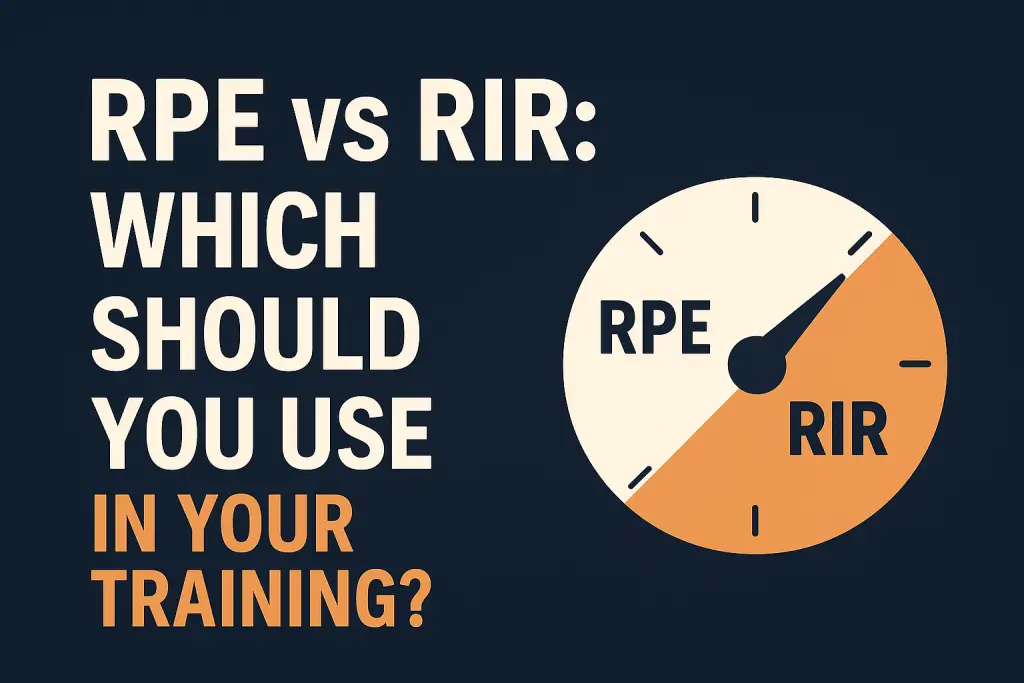RPE vs RIR: Which Should You Use in Your Training?

If you’ve been programming your workouts or following an intelligent training plan, you’ve probably come across two terms: RPE (Rate of Perceived Exertion) and RIR (Reps in Reserve). These tools are staples in auto-regulated training and used by powerlifters, bodybuilders, and coaches to fine-tune intensity.
But what exactly do they mean? And more importantly, which one should you use?
In this article, we’ll break down the difference between RPE and RIR, how they’re connected, and which might be best depending on your training goals.
What Is RPE in Strength Training?
RPE, or Rate of Perceived Exertion, is a scale (typically 1–10) that measures how hard a set feels:
- An RPE 10 means you couldn’t have done another rep.
- An RPE 8 means you had about 2 reps left in the tank.
This method helps lifters auto-regulate training based on fatigue, stress, and recovery—critical for long-term progress.
✅ Want to calculate your target load based on RPE and reps? Try our free RPE and RIR calculator.
What Is RIR (Reps in Reserve)?
RIR stands for Reps in Reserve—it’s a measure of how many reps you had left before failure.
It’s often used as a more intuitive or beginner-friendly system:
- If you finished a set and could’ve done 2 more reps, your RIR = 2.
- If you hit failure, your RIR = 0.
RIR is essentially the foundation of the RPE scale:
| RIR | Approximate RPE |
|---|---|
| 0 | 10 |
| 1 | 9 |
| 2 | 8 |
| 3 | 7 |
RPE vs RIR: What’s the Difference?
While both RPE and RIR estimate training intensity, the main difference is how they’re expressed:
- RPE gives a number based on perceived effort.
- RIR counts how many reps you had left in reserve.
Key Differences:
| Feature | RPE | RIR |
|---|---|---|
| Stands For | Rate of Perceived Exertion | Reps in Reserve |
| Scale | 1–10 | 0–5 (commonly) |
| Focus | Subjective difficulty | Remaining reps before failure |
| Best For | Intermediate to advanced lifters | Beginners and intermediates |
| Use Case | Auto-regulation, fatigue management | Programming intensity, deloading |
Which One Should You Use?
It depends on your experience level and training goals.
Use RIR if:
- You’re a beginner learning to gauge effort
- You want a simple way to manage intensity
- You’re training for hypertrophy and want to stop short of failure (typically 1–3 RIR)
Use RPE if:
- You’re an intermediate or advanced lifter
- You want more precision when adjusting training loads
- You need to program around recovery and fatigue fluctuations
💡 Pro Tip: Many programs use both. You might see RPE used to set training intensity, then use RIR feedback to confirm effort.
Practical Example
Let’s say you’re bench pressing:
- Set 1: 8 reps at 185 lbs feels like an RPE 8 — you had about 2 reps in reserve.
- Set 2: 8 reps at 195 lbs feels like an RPE 9 — 1 rep in reserve.
You’re using both RPE and RIR, even if only mentally.
Why These Tools Beat Percentage-Based Training
Using percentages (e.g. 80% of your 1-rep max) assumes you always perform the same regardless of sleep, stress, or nutrition.
RPE and RIR allow you to adjust based on how you feel—a strategy known as auto-regulation.
🛠️ Use our RPE/RIR calculator to input your weight, reps, and intensity target. It recommends smart adjustments based on your current effort.
Final Thoughts: RPE vs RIR
There’s no “one right way” — both RPE and RIR are science-backed tools that work.
What matters is:
- You’re using a consistent measure of effort
- It aligns with your goals (strength, hypertrophy, performance)
- You’re honest about your effort levels
Start with RIR if you’re new to tracking intensity. Level up to RPE when you need more precision.
Next Steps
- Use our RPE and RIR Calculator to find your optimal loads
- Bookmark this article for future reference
- Read more about RPE and RIR here.